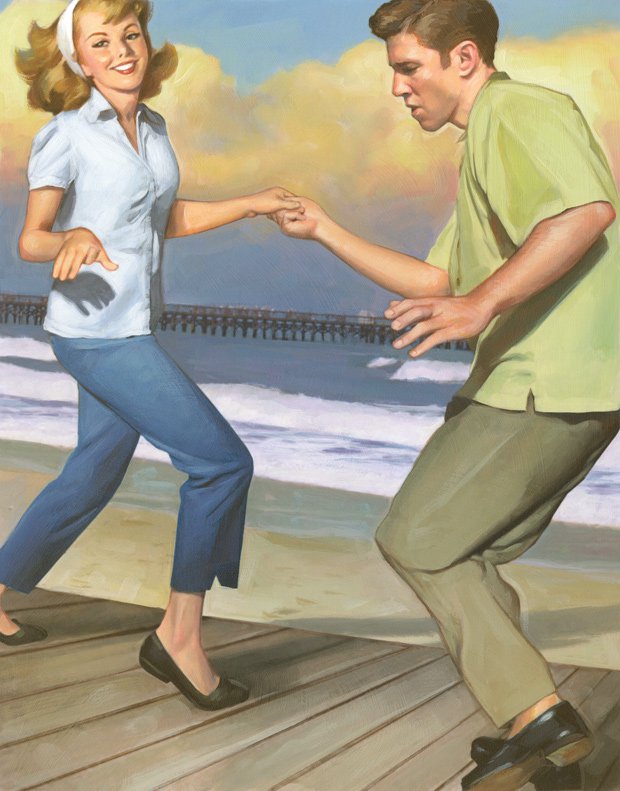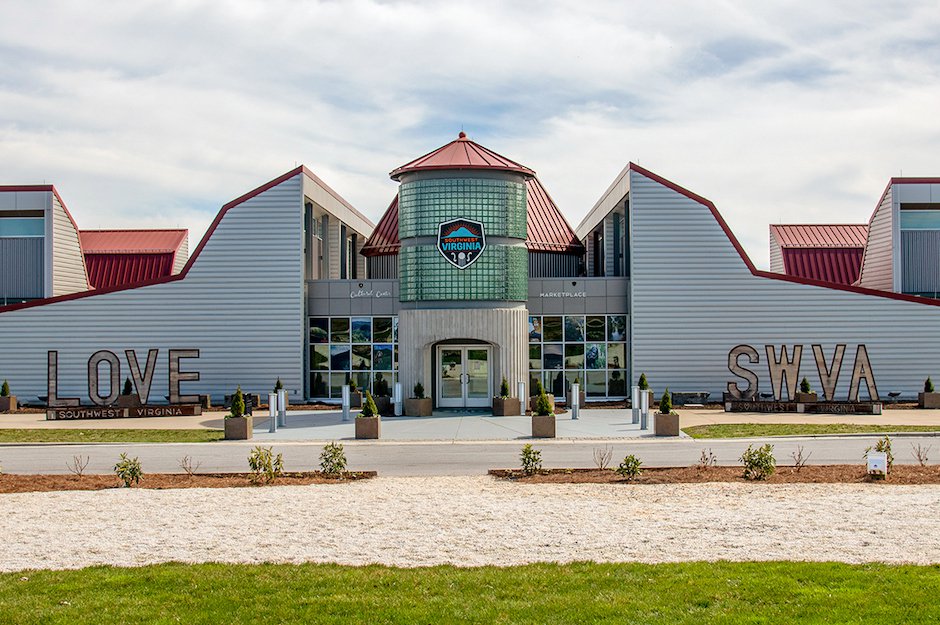What dance is closely associated with beach music, as Southern as “pouring salted peanuts into a sweating bottle of co-cola,” and still going strong after 75 years?

“See, this is the thing about the shag,” says Sid Strawderman of Midlothian, age 69, “it’s just cool.” It’s about 7:30 on an early-summer Tuesday night and members of the Richmond Shag Club are trickling into Visions Dance Club at the Double Tree Richmond-Midlothian in Southside for their weekly dance—expelling bursts of cigarette-infused air into the corridor each time they open the heavy door to the darkish club. An intermediate-level Carolina shag lesson is just wrapping up, and there is a break in the music as the DJ readies his set for the rest of the night. It will include beach music classics from The Tams and The Lamplighters as well as some contemporary country songs by Josh Turner and Lady Antebellum—songs with decidedly “shag-able” beats.
When the DJ lays down the first track of the night—Nappy Brown’s 1949 beach boogie and blues classic, “Drinkin’ Wine Spo Dee O Dee”— Strawderman, a two-time Virginia State Open Shag Champion who was inducted into the Virginia Shag Hall of Fame in 2007, grabs his partner, Jane Renger, age 44, of Midlothian, and they find a place among the 30 or so other couples crowding the dance floor. They spin and pivot, and do the Reverse Belly Roll, the Shifty and the Combination with a Triple Lean—pretty advanced steps in shag parlance—all while maintaining “the basic,” the core eight-count step. This is top-shelf shag.
Many Southerners love to shag, and we do it everywhere. We do the pretzel and attempt the pivot step at beach joints and seedy bars, at fraternity parties and country clubs, at street parties and weddings. And we shag wearing ball gowns and tuxedos just as often as we do it wearing Weejuns and frayed khakis. While more advanced dancers like Strawderman and Renger compete on the amateur shag circuit, and are striving to achieve the rank of professional (accomplished by winning a series of shag competitions), most of us are just trying to hold the basic through a whole rendition of The Drifters’ “Under the Boardwalk.”
The stylish and smooth shag has weathered some ups and downs in its nearly 80-year history, but today it is as popular as ever. Though it is the official state dance of both North and South Carolina, most Southerners lay claim to the iconic steps. Why? Because their buttery rhythm—meted out in eight counts: one and two, three and four, five six—conjures memories of insouciant summer days and ocean breezes, of a time when we thought life was, well, easier. And above all, according to journalist T. Edward Nickens, who wrote for Smithsonian Magazine in 2000, the shag is “as old-time Southern as pouring salted peanuts into a sweating bottle of ‘co-cola.’”
The shag has a deep history. It grew up alongside early rhythm and blues music performed by black musicians up and down the Atlantic coast in the 1930s and 1940s. Their undulating melodies—verboten at mainstream dance clubs at the time—could only be heard at beach clubs and on beach jukeboxes. The dance evolved from the more frenetic jitterbug and lindy hop: The big leaps and jumps of those dances were traded for the smoothness of the shag’s emphasis on footwork. The shag was danced on salt-sprayed wooden floors at beach pavilions from Virginia through the Carolinas and further south before migrating inland to basement parties and debutante balls alike. As Bo Bryan writes in his book, Shag: The Legendary Dance of the South, the shag just seems to fit what he calls the “Southern disposition”— living, working and dancing in a rhythm, he says, “most closely associated with the pendulum swing of a rope hammock.” Bryan muses that if the jitterbug is a “hot shot of vodka” then the shag is “a cool sip of charcoaled filtered whiskey.” It didn’t take long for the shag, once conceived (alas, attributable to no one individual), to soon become the symbol of beach life hipster cool.
“I grew up shagging. Everyone my age did,” says Joan McKinney, 68, a Greenville, South Carolina native who now lives in Springfield and is a member of the Northern Virginia Shag Club—a 240-member group that dances at the Arlington/Fairfax Elks Lodge every Wednesday. “This dance is a part of who we are,” she explains. “It is rooted in tradition.”
Rooted firmly enough to have survived several decades when it, and the beach music the shag depended upon, entered a period of dormancy, taking a backseat first to Elvis and then to the Beatles (we won’t even mention disco here) whose rhythms were definitely not “shag-able.” Hurricane Hazel added to the decline in 1954 when it razed many of the east coast clubs where the shag had reigned supreme.
But then in 1979, The Embers recorded “I Love Beach Music” (a song which would reach the level of cult classic), and in 1980 a Virginian named Gene “Swink” Laughter, a former lifeguard, orchestrated a 1980 reunion of beach bums and shag hounds at the clubs crowding Ocean Drive in North Myrtle Beach—what had been Mecca to shaggers up and down the coast during the dance’s heyday. Laughter expected 500 people to come—2,000 showed up. Near the end of the weekend-long party, Laughter named the group the Society of Stranders (S.O.S.) after South Carolina’s 60-mile-long Grand Strand.
The event pumped new life into the tradition of shag, and today S.O.S. takes place three times a year, packing up to 12,000 die-hard shaggers into Ocean Drive at its Fall Migration, Mid-Winter Classic and Spring Safari. Of the success of S.O.S. writes Bryan: “The grit was there and so was the glamour, and there was no question the shag still lived in the heart of Dixie.”
Several organizations, including the Shag Preservation Association, the Junior Shag Association and the Association of Carolina Shag Clubs, connect members of hundreds of local shag clubs across the Southeast and promote the dance and its culture. (Virginia has ten official shag clubs, and a robust junior competition circuit.) Every year the ACSC singles out a shagger from each club to receive the Icon Award, its highest honor. 2003 Icon Award winner Jan Weakley, age 76, a charter member of the Virginia Beach Shag Club (which meets at the Banque in Norfolk on Tuesday evenings), has been shag dancing and teaching since she attended her first S.O.S. in 1986. (Weakley says that she has attended S.O.S. three times a year ever since.) Of winning the award, she says: “The shag world is good. It’s the music I love, and the friendships I’ve made. It’s been a good way of life for me.”
But why has the shag endured—thrived, really—when so many dances have gone the way of the mashed potato or the Macarena, abandoned in the ever-shifting landscape of American pop culture?
“The heart of it is not pretentious,” says Patsy Arnett, age 62, of Richmond. “Anybody can dance the shag and you don’t have to be perfect.” Arnett, a North Carolina native, says she and her husband, Bruce, 63, also from North Carolina, shag-danced everywhere from football games at UNC Chapel Hill to parties on front porches when they were younger. (When she and Bruce were courting, while he was a student at UNC, she says she discovered he was then known as the “Shag King” of Chapel Hill—a claim he laughs about today.) The Arnett’s two adult children grew up listening to beach music and shagging: “My son is one of the best shaggers you’ll ever see,” she says.
A few weeks before I met Strawderman at the Richmond Shag Club, the Arnetts had invited him and Renger to teach the shag at an engagement party they were hosting at their West End Richmond home for the daughter of a friend, because, she explains, “Nothing will bring a party to life quicker than hearing a great shag song–people just spring to their feet when they hear it!” Their guests are still raving about it says Arnett.
Virginia Beach native Cindy Black, age 55, who, with husband Larry, has taught shag dancing in and around the peninsula since 1998 and who works as a DJ in the area, says, “A lot of shag is a family affair. A lot of junior shaggers have come to it through an aunt or uncle, or grandparent.” Black’s son, Brennar Goree, age 25, started shagging with his grandmother (Black’s mother) when he was eight years old. At the age of nine he started competing, and now he is the USA Grand National Shag Dance Champion. Says Black: “Be careful, when people come to the shag they get bit by the bug.”
“The shag is timeless, it appeals to all generations,” says Richard Crittenden, age 24, a junior at Elon University and a 2009 graduate of Richmond’s Collegiate School. “When I think of shag I think of the music—it’s party music. It’s feel-good music.” Crittenden says one of his favorite memories of shag dancing was when he was 12 or 13 and he and his family—parents, grandparents and two sisters—were at the Tides Inn in Irvington, relaxing in the lounge after a formal dinner. “Some beach music came on and my grandfather stood up and grabbed
my mom, then my grandmother grabbed me and we started shagging.” For Crittenden, “Dressing up and going out to dinner, and putting on your best and dancing is all about enjoying your family.”
“My father taught me to shag when I was six years old,” says 24-year-old Laura Dwight, a native of Richmond. She says she learned the basic to the music of The Spinners and Chairmen of the Board, but confides, “You can kind of fake it if you don’t know all the steps!” She says that in her set at USC, girls pick their party dates carefully because, “If you have a guy who knows how to shag he can whip you around the dance floor, and that’s what makes it fun. What girl doesn’t want to be twirled?”
David Hicks, drummer for the Raleigh, North Carolina-based Band of Oz—one of beach music’s most successful contemporary acts who have been performing and producing original songs since 1967—says he sees a lot of young people shagging at the beach concerts and parties the band plays throughout the Southeast. He attributes the continuity of the shag between generations to the music. (For the uninitiated, we’re not talking about the Beach Boys.) Says Hicks: “It’s almost impossible to be sad listening to The Tams’ [1968] ‘Be Young Be Foolish Be Happy’—it just sums up the whole beach culture.” And the shag, he says, brings people together. “We [the band] could go north and songs like ‘Ocean Boulevard’ or ‘Build Me Up’ won’t get much response, but at S.O.S.? They’ll scream and holler, and go crazy.” Adds Hicks, in a thick North Carolina drawl: “It’s like, we own this, this is ours.”
“When I think of what makes the shag so Southern,” explains Renger, “I think of the word hospitality. We welcome everyone.” All of the shaggers I have spoken to in my quest to suss out what it is that has kept the shag so rooted in Southern culture say the same thing, but perhaps it is 97-year-old Bill Long of Richmond, a member of the Richmond Shag Club, who says it best: “The dance is fun, but the people are better.”
As the last set winds down at Visions and I am saying my goodbyes to some of the 100 or so Richmond Shag Club members who have turned up tonight, Strawderman steps close, lowers his voice and leans in conspiratorially to tell me what really got him interested in the shag: “I got into it,” he whispers, “because I realized girls like to dance.”
—Want to start shag dancing? Find your nearest shag club via http://VirginiaLiving.com/Shag








